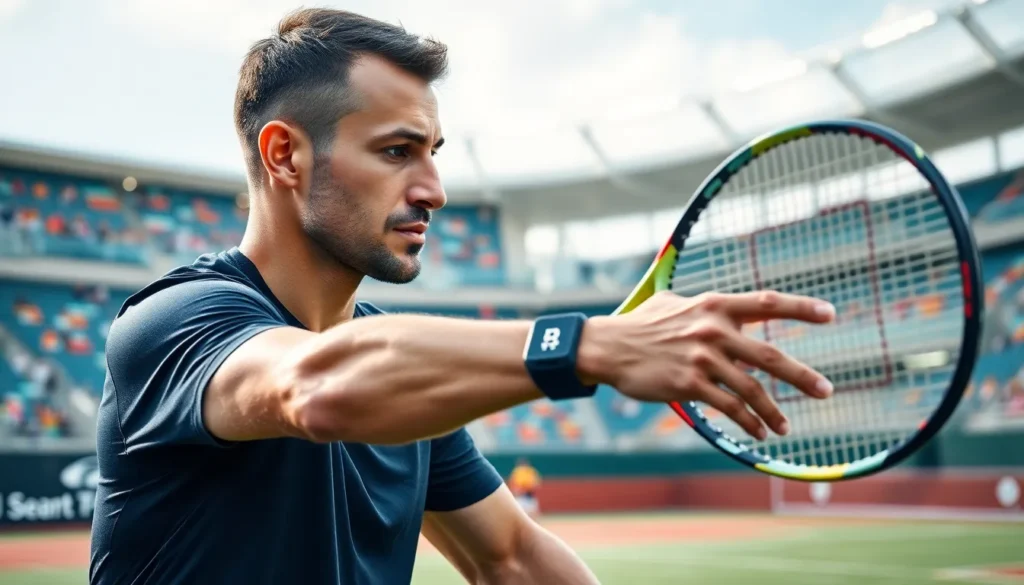In the fast-paced world of sports, technology is the secret sauce that’s changing the game. From smart wearables that track every heartbeat to advanced analytics that can make or break a season, sports tech is the MVP of modern athletics. It’s not just about the final score anymore; it’s about how data and innovation can turn athletes into superstars and teams into champions.
Sports Tech News
The sports industry continues to evolve with groundbreaking technologies enhancing performance and teamwork. Innovations in wearables and smart equipment are transforming how athletes train and compete.
Wearable Technology Advances
Wearable technology progresses rapidly, integrating sensors to track various performance metrics. Smart devices now monitor heart rate, sleep patterns, and activity levels in real-time. These innovations allow athletes to gain insights into their physical conditions during training and competitions. For example, companies like WHOOP provide valuable feedback from their performance tracking devices. Enhanced data collection aids coaches in tailoring training programs for individual athletes. Moreover, injury prevention becomes more effective through constant monitoring of physical load and fatigue levels, allowing for timely adjustments.
Smart Equipment Developments
Smart equipment fosters enhanced performance through intuitive design and data integration. Athletes now utilize equipment that analyzes technique and improves outcomes, such as smart tennis rackets and basketballs. Products from brands like Wilson and Spalding feature built-in sensors to provide performance feedback with each use. Teams incorporate smart balls to measure kick speed and trajectory, optimizing training sessions. Additionally, virtual reality training tools simulate game scenarios, helping players refine decision-making skills. These developments contribute to a comprehensive approach to athlete development, emphasizing both physical skills and strategic thinking.
Major Players in Sports Tech

The sports tech industry features several influential companies and innovative startups that drive advancements in performance and training.
Leading Companies in the Industry
IBM leads the charge with its AI-driven analytics, enhancing teams’ decision-making capabilities. Catapult Sports provides performance analysis solutions that help athletes improve their training. Wearable technology from Garmin tracks vital metrics, ensuring athletes can monitor their health. In addition, Under Armour combines fitness apps and smart clothing to optimize workout efficiency. These major players continue to shape the future of sports through cutting-edge technology and strategic collaborations.
Key Startups to Watch
Several startups are emerging as key players in sports tech. Whoop focuses on recovery and performance metrics. The platform offers detailed insights into strain and sleep, assisting athletes in reaching peak performance. PlayerTek uses GPS tracking to analyze player movement and performance during training sessions, providing coaches with crucial data. Zepp enhances skill development through sensor-driven feedback for various sports. Startups like these underscore the dynamic landscape of sports technology, contributing to the evolution of athletic training and performance.
Impact of Sports Tech on Athletes
The integration of technology in sports significantly influences athlete performance and health. Innovations such as performance enhancement tools and injury prevention solutions play pivotal roles in shaping modern athletic training.
Performance Enhancement Tools
Smart wearables offer real-time performance metrics, enabling athletes to track speed, heart rate, and stamina. Data derived from these devices helps in optimizing workout routines. Coaches use analytics software to assess player efficiency, crafting training programs tailored to individual needs. Smart equipment, including racquets and sensors, provides immediate feedback on technique. Virtual reality training enhances strategic gameplay by immersing athletes in simulated environments. These advancements equip athletes to perform optimally during competitions.
Injury Prevention Solutions
Wearable technology contributes to monitoring fatigue and identifying potential injury risks. Continuous tracking of biomechanics alerts teams to abnormal movement patterns. Physiological data assists in designing injury prevention programs. The integration of recovery tracking devices helps athletes manage rest periods, reducing overtraining. Rehabilitation technology offers personalized recovery exercises based on injury assessments. Ensuring athletes maintain peak physical condition becomes achievable through these innovative solutions.
Trends Shaping the Future of Sports Tech
Technological advancements continue to drive the evolution of sports, transforming various aspects of training and gameplay. The integration of data analytics and immersive technologies is leading the charge.
Data Analytics in Sports
Data analytics plays a crucial role in optimizing athletic performance. Teams utilize sophisticated algorithms to analyze player statistics and game footage. Coaches make decisions backed by data, identifying strengths and weaknesses in player performance. Real-time metrics collected from wearables enhance training strategies tailored to individual athletes. Insights from analytics software lead to improved game strategies, fostering a deep understanding of opponent dynamics. Teams that leverage data gain a competitive edge, increasing their chances for success during crucial matchups.
Virtual Reality and Augmented Reality Applications
Virtual reality and augmented reality are revolutionizing athlete training and fan engagement. These technologies simulate real-world scenarios, enabling athletes to practice complex skills in immersive environments. By creating detailed game situations, athletes can refine their decision-making and tactical awareness. Additionally, augmented reality applications enhance fan experiences during live events, providing interactive overlays that enrich gameplay understanding. Those engaged in both training and spectating benefit significantly from these cutting-edge tools, making sports more exciting and accessible than ever.
Conclusion
The integration of technology in sports continues to reshape how athletes train and compete. With innovations in wearables and data analytics, athletes are not just improving their performance but also enhancing their overall health and longevity in their careers. As major companies and startups push the boundaries of what’s possible, the future of sports tech looks promising and exciting.
These advancements not only optimize training but also elevate the fan experience, making sports more engaging than ever. As technology evolves, it will undoubtedly play an even more critical role in the success of athletes and teams alike, paving the way for a new era in sports.



